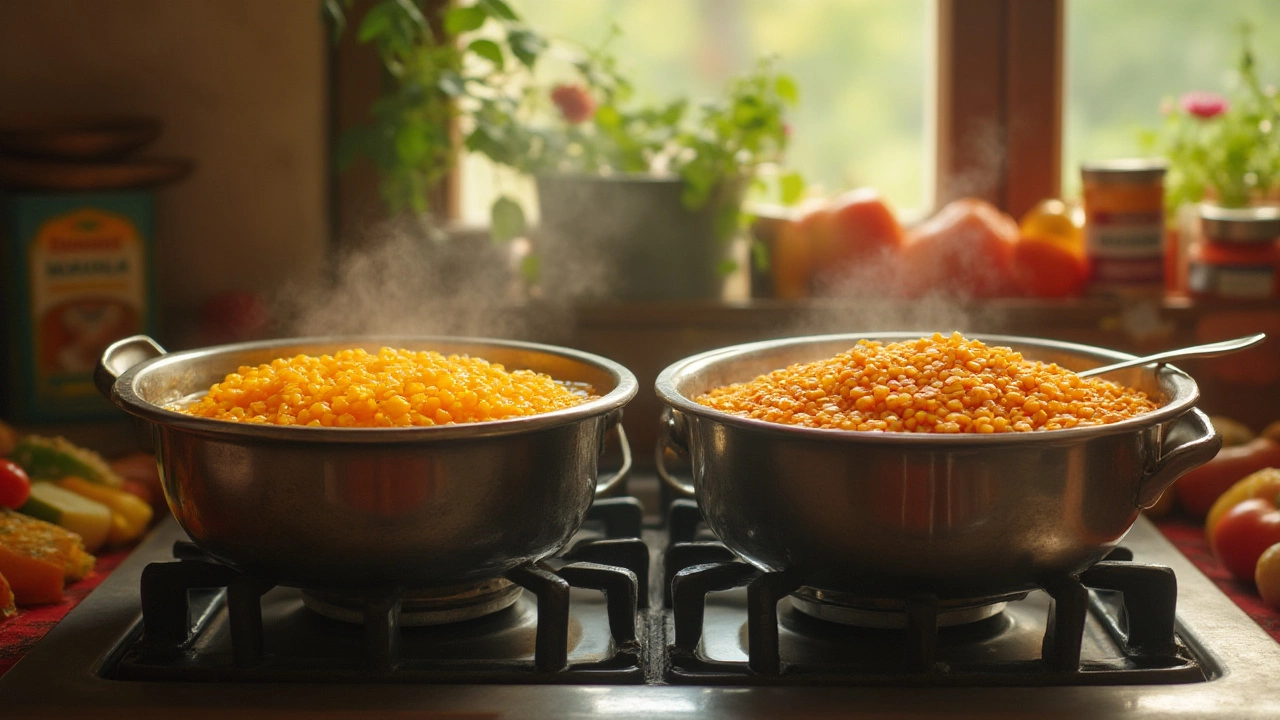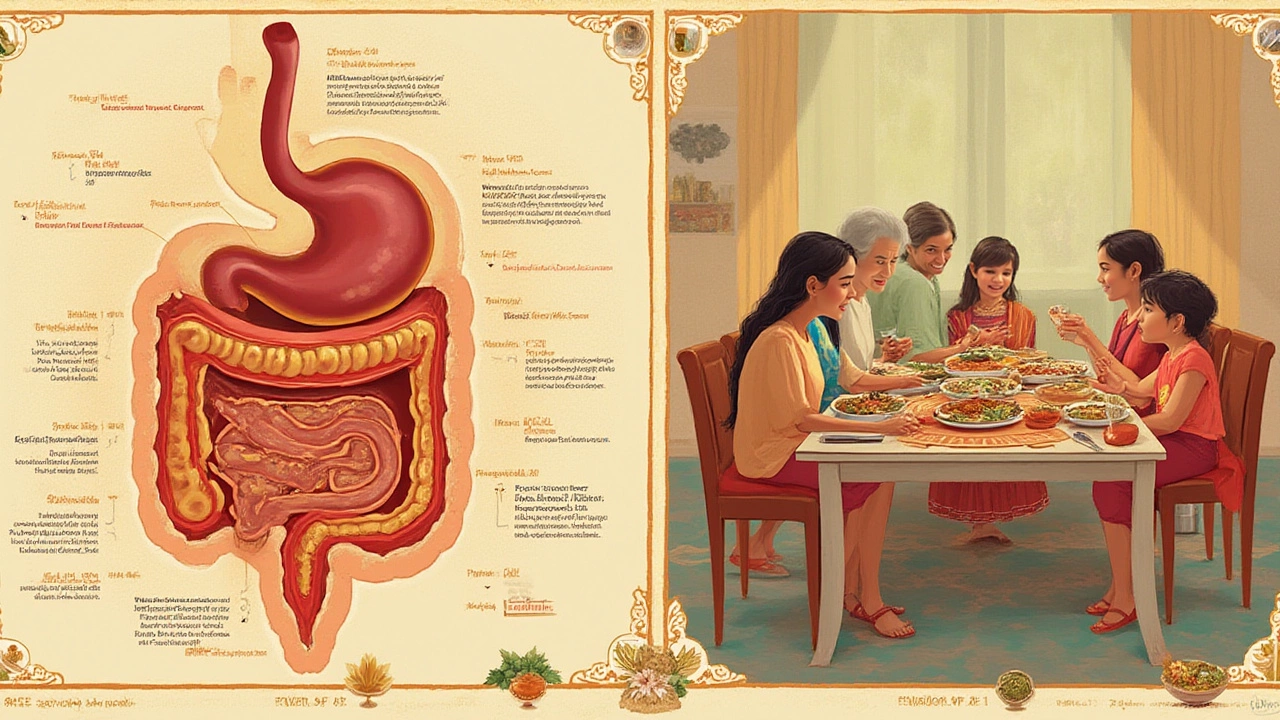What Happens If You Don't Soak Dal? Health, Nutrition, and Cooking Explained
 Aug, 1 2025
Aug, 1 2025
Ever tossed dal straight into the pot because you ran out of time or just didn’t want to bother soaking it? You’re not alone—every kitchen has faced that moment. But what’s the real deal? Does soaking actually matter, or is it just another old habit that you can skip? It turns out, the choice between soaking or not can mess with the whole game. Not only does it change how your dal cooks and tastes, but it could also affect how your stomach feels later. Some call it convenience; others call it sabotage. Let’s get into the nitty-gritty of what really happens if you skip that soak and why your pressure cooker, your gut, and the final flavor all care about this humble ritual.
The Science of Soaking: What’s Really Going On?
When you soak dal, you’re doing more than making your cooking routine a bit more old-fashioned. You’re triggering all sorts of chemical changes inside those small, powerhouse lentils. Dal, whether it’s chana, masoor, toor, urad, or moong, is protected by tough walls made mostly of cellulose and hemicellulose. Soaking starts to soften that hard coat and, more importantly, kicks off little enzyme parties inside each grain. As water sneaks through the dal’s shell, it starts breaking down some of the starches—starches that otherwise can cause that heavy, bloated feeling. Enzymes, natural to the seed, wake up and start chopping away at these starches and certain tricky proteins, making them easier for your body to handle.
Why does this matter? It’s all about making the dal more digestible. There are complex sugars in legumes called oligosaccharides, known for causing gas and bloating—you know, the sort that can turn a cozy dinner into a symphony you hadn’t planned on. Soaking dissolves some of these sugars in the water. If you toss that water and rinse before cooking, you’re literally washing out a good chunk of the troublemakers. There was even a small study in 2020 by the Indian Institute of Food Processing Technology that found soaking urad dal reduced these problematic sugars by 30%. That’s a huge deal if your stomach is on the sensitive side.
The science doesn’t stop there. Soaking softens the dal, so when you finally hit the “on” button on your cooker, it cooks faster and more evenly. No more crunchy centers with mushy edges. And yes, the mineral content takes a bit of a hit—you’ll lose some iron, potassium, and magnesium in the soak water—but it’s pretty modest. What you gain in digestibility could easily outweigh that minor loss, and many cooks argue that adding a squeeze of lemon or pairing the dish with a veggie side brings plenty of those nutrients right back into your meal.
One big bonus? Soaking can also reduce the cooking time by a huge margin. Most traditional dals, left to soak for 6–8 hours or overnight, can be ready in just 15–20 minutes of pressure cooking, compared to up to an hour or more for unsoaked. That means less gas or power used, which in India especially can translate to real savings over time—good for your wallet and the planet. And speaking of nutrients and planet: soaking, then rinsing your dal, can cut pesticide residues. Farmers sometimes spray legumes with anti-mold and insect chemicals after harvest, and while not all dal has this issue, it’s another reason why that simple soak matters.

What Happens If You Skip Soaking: Texture, Taste & Digestive Drama
If you shrug and throw the dal straight into the patila (pot), you’re going to see a few things right away, and some sneak up on you later. First, get ready for a longer cooking session. Unsoaked dal, with its hard outer shell, demands more energy and patience. It’s common for toor dal to take up to twice as long in the cooker if you skip soaking—meaning more whistles and maybe even a burnt bottom if you get distracted. The uneven cooking becomes a pain, too; some bits fall apart, while others stay stubbornly solid.
Texture-wise, things get unpredictable. Soaked dal turns out soft, creamy, and blends beautifully with masala. When you skip soaking, there’s a risk that your dal will stay grainy or gritty. This is especially true for larger lentils, like chana dal or whole urad. A proper dal makhani should melt on your tongue, not stick in your teeth. For moong dal or masoor dal, which are softer by nature, the difference is less dramatic, but you’ll still notice a change in mouthfeel and overall comfort.
The taste doesn’t escape, either. Unsoaked dal tends to carry a raw, almost grassy or earthy aftertaste if it doesn’t fully cook down. This can overpower the delicate flavors of ghee, hing, jeera, garlic, or whatever else you build your tadka with. Soaking washes away some of this bitterness, letting the flavors shine. Skip it, and even the most carefully made tadka can feel weaker, like background noise instead of the star of the show.
But honestly, for most people, the biggest consequence is in the stomach department. Those gas-forming oligosaccharides we talked about earlier? They’re still right there, waiting to ferment happily away in your gut. It’s not just about “feeling heavy”—for some, it can mean real discomfort: bloating, cramps, or just a sluggish, low-energy feeling. Some folks with sensitive digestion or IBS have a harder time with unsoaked lentils, and every grandma will tell you the same: the classic way gives you fewer complaints later. If you have kids or elders at home, skipping the soak can lead to extra crankiness around dinnertime.
There’s also the problem of so-called “anti-nutrients.” These are naturally found in dal, like phytic acid and tannins. They hang on to minerals like iron and zinc, making them harder for your body to absorb. Soaking can lower anti-nutrient levels by up to 40%, according to some 2021 research published in the Journal of Food Science and Technology, which means your body actually gets more out of every spoonful. That’s worth a few hours’ wait, don’t you think?

Tips, Tricks, and When You Can Skip the Soak
Now, not everybody has the patience or foresight to plan dal the night before. Sometimes, you want dinner in a hurry. Here’s some relief: you don’t have to soak every dal, every time. Moong dal split and masoor dal cook up pretty soft even without a soak, especially with a good pressure cooker. But for anything bigger or tougher—whole urad, chana dal, or kidney beans (rajma)—soaking isn’t just a tip, it’s non-negotiable if you want easy cooking and gentle digestion.
If you forgot to soak, don’t panic. There’s a sneaky trick called the “quick soak.” Pour boiling water over your dal and let it sit, covered, for 1–2 hours. It’s not the same as an 8-hour overnight soak, but it gets you halfway there. And if you’re in a total rush, add a pinch of baking soda while cooking. It helps soften the grains faster, but go easy—too much, and you risk an odd taste and mushy mess.
Here’s another one: after soaking, always rinse well and throw away the soak water. That’s where most of the anti-nutrients, bitter stuff, and pesticides get dumped. Cook your dal with fresh water every time.
If you’re chasing nutrition, soaking isn’t enough. Pair your dal with vitamin C—like a squeeze of lemon or a tomato-based curry. This helps your body absorb more iron. Fermenting dal batters (like for idli or dosa) actually pushes anti-nutrient levels even lower and increases B-vitamins, so if you’re planning something special, let nature do its work for a day.
Take a look at the following table for common dals in Indian kitchens and the suggested soak time:
| Type of Dal | Typical Soak Time (Hours) | Reduction in Cooking Time | Impact If Not Soaked |
|---|---|---|---|
| Chana Dal | 6–8 | Up to 50% | Hard texture, gas |
| Toor Dal | 4–6 | Up to 40% | Longer cooking, rough texture |
| Urad Dal (whole) | 8–12 | Up to 60% | Very hard, poor taste |
| Masoor Dal | 1–2 | Up to 20% | Mild difference |
| Moong Dal | 0–1 | Minimal | Minor texture change |
Got a slow cooker? Soaking is even more vital—otherwise, dal can stay stubborn and undercooked for hours. For pressure cookers, you’ll use far less energy and avoid scorching.
To sum it up, if you want dal that cooks up quick, tastes mellow, and sits gentle on your belly, don’t ditch the soak. It’s not just a tradition; it’s a science-backed step, and even the most rushed cook can benefit from planning ahead. Your digestive system—and whoever shares your table—will notice the difference after just one meal.